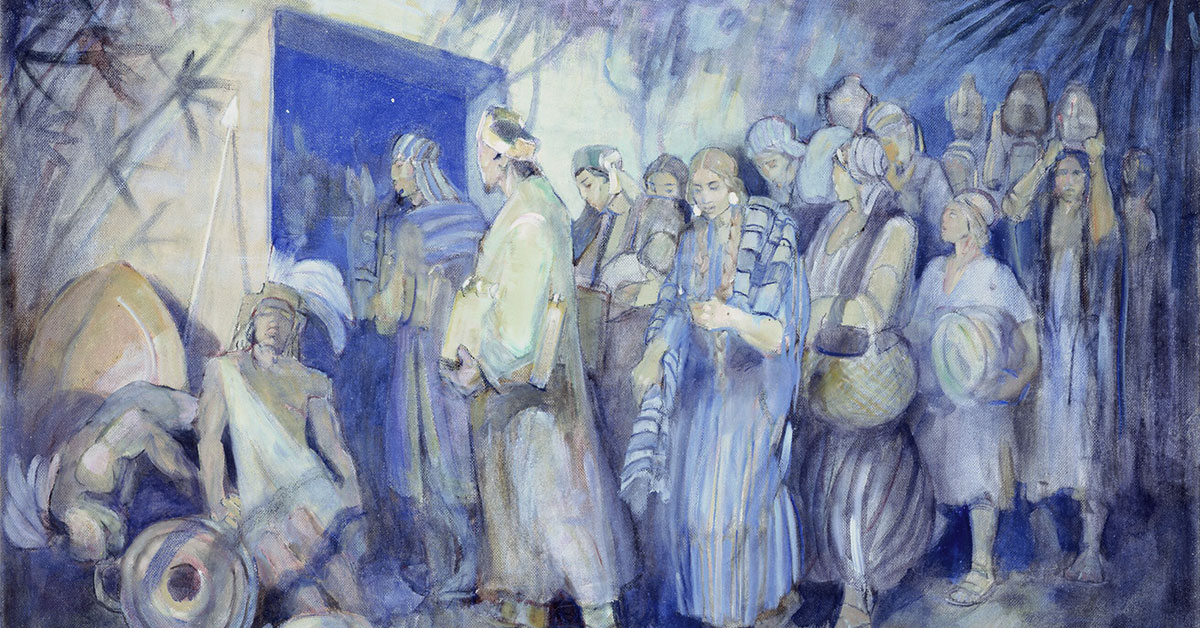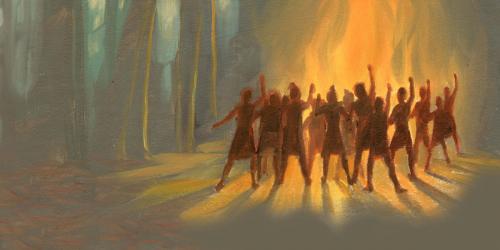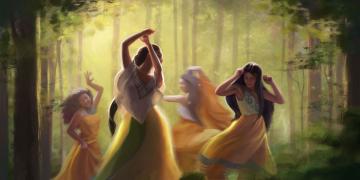You are here
Book of Mormon Central is in the process of migrating to our new Scripture Central website.
We ask for your patience during this transition. Over the coming weeks, all pages of bookofmormoncentral.org will be redirected to their corresponding page on scripturecentral.org, resulting in minimal disruption.
Come Follow Me 2020: Mosiah 18-24

Scripture Block
Mosiah 18-24
May 11–17. We Have Entered into a Covenant with Him
KnoWhys
Recommended Resources
Learn about the Book of Mormon with verse by verse commentaries from renowned Book of Mormon scholars like John W. Welch and Brant A. Gardner in the ScripturePlus app. Read this week's KnoWhy connected with the Come Follow Me curriculum, and watch a video elucidating an insight in this week's scripture reading.
Reading Plan
Structure your personal scripture study by following a multimedia, day by day plan. Each day's assignment includes the required scripture passages from the Come Follow Me curriculum, as well as suggestions for additional resources to bring context and understanding to your study. To dive deep, skip down to "Additional Resources" for a bibliography on Mosiah 18–24.
Monday
- Scripture: Mosiah 18:1–18
- Chart: Why Did the Nephites Practice Baptism?
- KnoWhy 97: At Baptism, What Do We Covenant to Do?
- Scripture: Mosiah 18:19–35
- Video: Why is the Sabbath Day Needed?
Explore Further
- KnoWhy 320: Why Did the Nephites Practice Baptism?
- KnoWhy 303: Why is the Sabbath Day Needed?
Tuesday
- Scripture: Mosiah 19:1–8
-
Quote: “War poses some crucial problems for the individual. What happens when a peaceful, loving, and God-fearing person is trained to take the lives of others? What happens when that person enters an environment in which neither life is respected nor God revered? Can an individual in those circumstances survive spiritually?“
Answers to those questions also lie in the Book of Mormon. Several examples show that people can live righteously under the most adverse conditions. Zeniff and Gideon, for instance, were two fine men who fought in mixed armies--good and bad--and survived civil war. (See Mosiah 9:1-3; Mosiah 19:1-8; 18-24; Mosiah 20: 17-22.) . . . Mormon and his son Moroni led a people that had abandoned God. Yet each remained committed and loyal to God and lived a righteous life”
Garrett, H. Dean. “Peace Within”. Ensign, September 1988, 25. - Scripture: Mosiah 19:9–29
-
Quote: “The oath made with the Lamanite king by the newly appointed King Limhi (vv. 25– 26) fulfilled another of Abinadi’s prophecies. The Lord had said through him: ‘This generation, because of their iniquities, shall be brought into bondage’ (Mosiah 12: 2)”
Nyman, Monte S. These Records Are True: A Teaching Commentary on Jacob through Mosiah, 2:436. Orem, UT: Granite, 2004. -
Quote: “Noah . . . did not provide for succession to his throne. Instead, his son Limhi was appointed king by the people after his father’s kingdom had collapsed (Mosiah 19:26). There is no record of Noah’s ever having taught Limhi about royal responsibilities. Ironically, Limhi’s first official act of government was to indenture his people to the Lamanites. Noah’s reign brought about his people’s bondage and landed his son in a political quagmire.”
Donaldson, Lee L. “Benjamin and Noah: The Principle of Dominion.” Essay. In The Book of Mormon: Mosiah, Salvation Only through Christ, edited by Monte S. Nyman and Charles D. Tate, 53-54. Salt Lake City, UT: Greg Kofford Books, 1991.
Wednesday
- Scripture: Mosiah 20:1–26
- KnoWhy 98: Why did the Lamanites Break Their Treaty with King Limhi?
Thursday
- Scripture: Mosiah 21:1–11
- Video: How Can We Stop the Cycle of Revenge?
- Scripture: Mosiah 21:12–36
- KnoWhy 99: Which Nephite King Had the Gift of Interpretation?
Explore Further
- KnoWhy 381: How Can We Stop the Cycle of Revenge?
Friday
- Scripture: Mosiah 22:1–16
- KnoWhy 100: Why Did King Limhi Think Gideon’s Escape Plan Would Work?
Saturday
- Scripture: Mosiah 23:1–39
- KnoWhy 101: Why Does the Book of Mosiah Talk So Much About Priesthood Authority?
Explore Further
Sunday
- Scripture: Mosiah 24:1–17
- KnoWhy 102: How Does the Lord Make our Burdens Light?
- Scripture: Mosiah 24:18–25
- KnoWhy 238: Why Should We Take the Time to Give Thanks to God?
Additional Resources
Mosiah 18
Welch, John W., and Greg Welch. “Journeys Indicating Distances.” In Charting the Book of Mormon: Visual Aids for Personal Study and Teaching. Provo, UT: Foundation for Ancient Research and Mormon Studies, 1999, chart 152.
Welch, John W., and Greg Welch. “Further Details in the Land of Nephi.” In Charting the Book of Mormon: Visual Aids for Personal Study and Teaching. Provo, UT: Foundation for Ancient Research and Mormon Studies, 1999, chart 154.
Mosiah 18:1–5
Bowen, Matthew L. “Alma — Young Man, Hidden Prophet.” Interpreter: A Journal of Mormon Scripture 19 (2016): 343–353.
Mosiah 18:8–10
Book of Mormon Central. “Why Did the Nephites Practice Baptism? (Mosiah 18:8–10).” KnoWhy 320 (May 31, 2017).
Book of Mormon Central. “At Baptism, What Do We Covenant to Do? (Mosiah 18:10).” KnoWhy 97 (May 11, 2016).
Bowen, Matthew L. “’This Son Shall Comfort Us’: An Onomastic Tale of Two Noahs.” Interpreter: A Journal of Mormon Scripture 23 (2017): 263–298.
Bowen, Matthew L. “’Most Desirable Above All Things’: Onomastic Play on Mary and Mormon in the Book of Mormon.” Interpreter: A Journal of Mormon Scripture 13 (2014): 27–61.
Peterson, Daniel C. “On Being a Tool.” Interpreter: A Journal of Mormon Scripture 19 (2016): vii–xv.
Reynolds, Noel B. “Understanding Christian Baptism through the Book of Mormon.” BYU Studies Quarterly 51, no. 2 (2012): 3–37.
Welch, John W., and Greg Welch. “Baptism of Alma's People at the Waters of Mormon.” In Charting the Book of Mormon: Visual Aids for Personal Study and Teaching. Provo, UT: Foundation for Ancient Research and Mormon Studies, 1999, chart 59.
Welch, John W., and Greg Welch. “Book of Mormon Covenant Language.” In Charting the Book of Mormon: Visual Aids for Personal Study and Teaching. Provo, UT: Foundation for Ancient Research and Mormon Studies, 1999, chart 58.
Mosiah 18:11
Calabro, David. “’Stretch Forth Thy Hand and Prophesy’: Hand Gestures in the Book of Mormon.” Journal of the Book of Mormon and Other Restoration Scripture 21, no. 1 (2012): 46–59.
Mosiah 18:13, 15–17, 21
Ricks, Stephen D. “Miqvaot: Ritual Immersion Baths in Second Temple (Intertestamental) Jewish History.” BYU Studies Quarterly 36, no. 3 (1996–7): 277–286.
Woodford, Robert J. “I Have a Question: How much do we know about baptism before Christ’s time?” Ensign (July 1991).
Mosiah 18:25
Book of Mormon Central. “Why is the Sabbath Day Needed? (Mosiah 18:25).” KnoWhy 303 (April 21, 2017).
Mosiah 19
Mosiah 19:23–24
Tvedtnes, John A. “The Nephite Purification Ceremony.” In The Most Correct Book: Insights from a Book of Mormon Scholar, 176–186. Salt Lake City: Cornerstone Publishing, 1999.
Mosiah 20
Mosiah 20:1
Welch, John W., Robert F. Smith, and Gordon C. Thomasson. “Dancing Maidens and the Fifteenth of Av.” In Reexploring the Book of Mormon, edited by John W. Welch, 139–141. Provo, UT/Salt Lake City: FARMS/Deseret Book, 1992.
Mosiah 20:1–5
S. Kent Brown. “Marriage and Treaty in the Book of Mormon: The Case of the Abducted Lamanite Daughters.” In From Jerusalem to Zarahemla: Literary and Historical Studies of the Book of Mormon, 99–112. Provo, UT: Religious Studies Center, Brigham Young University, 1998.
Goff, Alan. “The Stealing of the Daughters of the Lamanites.” In Rediscovering the Book of Mormon, edited by John L. Sorenson, 67–74. Provo, UT: FARMS, 1991.
Bowen, Donna Lee and Camille S. Williams. “Women in the Book of Mormon.” In The Encyclopedia of Mormonism, ed. Daniel H. Ludlow (New York, NY: Macmillan, 1992) 4:1577–1580.
Mosiah 20:18
Book of Mormon Central. “Why did the Lamanites Break Their Treaty with King Limhi? (Mosiah 20:18).” KnoWhy 98 (May 12, 2016).
Mosiah 20:22
Geddes, Ross. “Patrick Henry, Gideon, and the Book of Mormon.” Insights: A Window on the Ancient World 24, no. 3 (2004): 2.
Mosiah 21
Mosiah 21:11
Book of Mormon Central. “How Can We Stop the Cycle of Revenge? (Mosiah 21:11).” KnoWhy 381 (November 14, 2017).
Mosiah 21:27
Reeve, Jr., Rex C. “The Book of Mormon Plates.” In The Book of Mormon: First Nephi, The Doctrinal Foundation, edited by Monte S. Nyman and Charles D. Tate, Jr., 99–111. Provo, UT: Religious Studies Center, Brigham Young University, 1988.
Mosiah 21:28
Book of Mormon Central. “Which Nephite King Had the Gift of Interpretation? (Mosiah 21:28).” KnoWhy 99 (May 13, 2016).
Johnson, J. Cooper “King Benjamin or Mosiah: A Look at Mosiah 21:28.” FairMormon.
Norwood, L. Ara. “Benjamin or Mosiah? Resolving an Anomaly in Mosiah 21:28.” FairMormon Conference 2001. Provo, UT: FairMormon, 2001.
Mosiah 22
Smoot, Stephen O. “The Divine Council in the Hebrew Bible and the Book of Mormon.” Interpreter: A Journal of Mormon Scripture 27 (2017): 155–180.
Mosiah 22:6
Book of Mormon Central. “Why Did King Limhi Think Gideon’s Escape Plan Would Work? (Mosiah 22:6).” KnoWhy 100 (May 16, 2016).
Williams, Clyde J. “Deliverance from Bondage.” In The Book of Mormon: Mosiah, Salvation Only Through Christ, edited by Monte S. Nyman and Charles D. Tate, Jr., 261–274. Provo, UT: Religious Studies Center, Brigham Young University, 1991.
Mosiah 22:14
Reeve, Jr., Rex C. “The Book of Mormon Plates.” In The Book of Mormon: First Nephi, The Doctrinal Foundation, edited by Monte S. Nyman and Charles D. Tate, Jr., 99–111. Provo, UT: Religious Studies Center, Brigham Young University, 1988.
Mosiah 23
Hardy, Heather. “Another Testament of Jesus Christ: Mormon’s Poetics.” Journal of Book of Mormon Studies 16, no. 2 (2007): 16–27, 93–95.
Welch, John W., and Greg Welch. “From Nephi to Zarahemla: Alma's Escape.” In Charting the Book of Mormon: Visual Aids for Personal Study and Teaching. Provo, UT: Foundation for Ancient Research and Mormon Studies, 1999, chart 155.
Mosiah 23:7–8
Tvedtnes, John A. “Some Aspects of Nephite Kingship.” In The Most Correct Book: Insights from a Book of Mormon Scholar, 187–193. Salt Lake City: Cornerstone Publishing, 1999.
Mosiah 23:9–10
Bowen, Matthew L. “’This Son Shall Comfort Us’: An Onomastic Tale of Two Noahs.” Interpreter: A Journal of Mormon Scripture 23 (2017): 263–298.
Mosiah 23:17
Book of Mormon Central. “What Does the Book of Mormon Teach about the Priesthood? (Mosiah 23:17).” KnoWhy 289 (March 20, 2017).
Book of Mormon Central. “Why Does the Book of Mosiah Talk So Much About Priesthood Authority? (Mosiah 23:17).” KnoWhy 101 (May 17, 2016).
Peterson, Daniel C. “Priesthood in Mosiah.” In The Book of Mormon: Mosiah, Salvation Only Through Christ, edited by Monte S. Nyman and Charles D. Tate, Jr., 187–210. Provo, UT: Religious Studies Center, Brigham Young University, 1991.
Peterson, Daniel C. “Authority in the Book of Mosiah.” The FARMS Review 18, no. 1 (2006): 149–185.
Mosiah 23:18–25
Lindsay, Jeff. “The Possibility of Janus Parallelism in the Book of Mormon.” Interpreter: A Journal of Mormon Scripture 28 (2018): 1–20.
Mosiah 24
Bowen, Matthew L. “’This Son Shall Comfort Us’: An Onomastic Tale of Two Noahs.” Interpreter: A Journal of Mormon Scripture 23 (2017): 263–298.
Welch, John W., and Greg Welch. “From Nephi to Zarahemla: Alma's Escape.” In Charting the Book of Mormon: Visual Aids for Personal Study and Teaching. Provo, UT: Foundation for Ancient Research and Mormon Studies, 1999, chart 155.
Welch, John W., and Greg Welch. “Flashbacks in the Book of Mosiah.” In Charting the Book of Mormon: Visual Aids for Personal Study and Teaching. Provo, UT: Foundation for Ancient Research and Mormon Studies, 1999, chart 29.
Mosiah 24:15
Book of Mormon Central. “How Does the Lord Make our Burdens Light? (Mosiah 24:15).” KnoWhy 102 (May 18, 2016).
Bednar, David A. “Bear Up Their Burdens with Ease.” Ensign, May 2014, 87–90.
Clayton, L. Whitney “That Your Burdens May Be Light.” Ensign, November 2009, 12–14.
Kapp, Ardeth G. “Pray Not for Light Burdens but for Strong Backs.” BYU Devotional, April 29, 2004.
Mosiah 24:22
Book of Mormon Central. “Why Should We Take the Time to Give Thanks to God? (Mosiah 24:22).” KnoWhy 238 (November 14, 2016).




